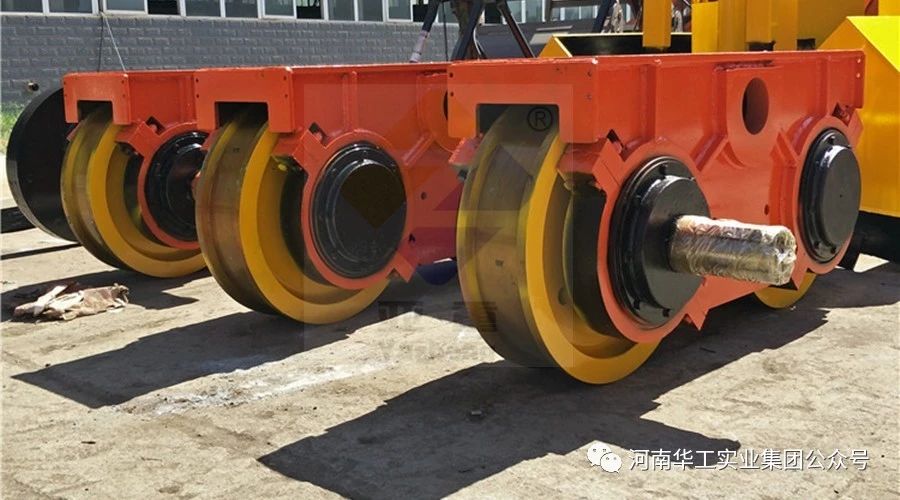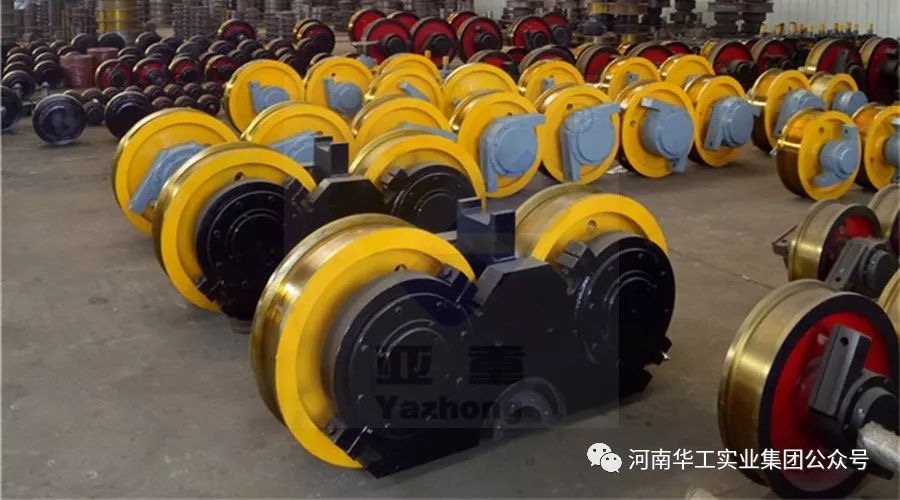Crane running organisation usually only four automatic and slave wheels, if the lifting capacity is very large, commonly used to add wheels to reduce wheel pressure. When the wheel exceeds four, it is necessary to use the articulated equalisation frame equipment, so that the crane load is evenly spread on the wheels.

The metal structure of the bridge consists of the main girder and the end girder, and is divided into two categories: single main girder bridge and double girder bridge. Single main girder bridge consists of a single main girder and end girders located at both ends of the span, double girder bridge consists of two main girders and end girders.
The main girder and end girder rigid connection, end girder ends are equipped with wheels, used to support the bridge in the overhead running. The main girder is welded with track for lifting trolley operation. The main girder of the bridge has more types of structure than the typical box structure, four truss structure and hollow web truss structure.
The box structure can be divided into several types, such as box double girder, box double girder, single main girder, and so on. Positive rail box-shaped double girder is widely used in a basic form, the main girder consists of upper and lower flange plate and both sides of the straight web, the trolley rails are placed on the base line of the upper flange plate, its structure is simple, easy to produce, suitable for batch production, but with a larger weight.
The cross-section of deviated rail box-type double beam and deviated rail box-type single main beam are composed of upper and lower flange plate and unequal thickness of main and vice web plate, and the trolley rail is placed above the main web plate, and the short stiffening plate in the box body can be eliminated, and the deviated rail box-type single main beam is made of a wide flange box-type main beam instead of two main beams, and the deadweight is smaller but the production is more messy. The four truss structure is combined by four plane trusses to form a closed space structure, and there is usually a platform plate on the appearance of the upper horizontal truss, which has light deadweight and large stiffness, but compared with other structures, it has large external dimensions, messy production and low fatigue strength, so it has been produced less often.
Hollow truss structure is similar to off-rail box-shaped main beam, by four pieces of steel plate constitutes a closed structure, in addition to the main web for the solid web I-beam, the other three pieces of steel plate according to the planning requirements cut into a lot of windows, constituting a hollow truss without diagonal bars, in the upper and lower horizontal truss appearance is paved with a platform plate, semi-portal crane operating organisation and electrical equipment installed in the bridge inside the frame, the deadweight is light, and the overall stiffness of the big, which in China is This is a more widely used type in China.
Usually the bridge crane is mainly driven by electric power, usually operated in the driver's room, there are also remote control. The lifting capacity can be up to 500 tonnes and the span can be up to 60 metres.
Simple beam overhead travelling crane, also known as beam crane, its structure is similar to the usual bridge crane, lifting capacity, span and working speed are smaller. The main beam of the bridge is a simple section beam composed of I-beam or other steel sections and plate steel, with a hand hoist or electric hoist with a simple trolley as a lifting trolley, the trolley is usually run on the lower flange of the I-beam. The bridge can run along the track on the overhead, but also can run along the track suspended below the overhead, this crane is called suspension beam crane.
Metallurgical special bridge crane in the steel production process can participate in specific technical operations, its basic structure and the usual bridge cranes are similar, but in the lifting trolley is also equipped with special work organisation or equipment. The work of this crane is characterised by frequent use, harsh conditions and high working levels. There are five preferred types.
Simple beam overhead crane type casting crane: for lifting iron written into the mixed iron furnace, steelmaking furnace and lifting steel written into the continuous ingot casting equipment or ingot moulds and so on. The main trolley lifting bucket, vice trolley for turning the bucket and other auxiliary work.
Clamp crane: the use of clamps will be high-temperature ingot straight lifting to the pit even heat furnace, or take it out to the ingot car.
Ingot removal crane: used to force the ingot out of the ingot mould. There are special desinging equipments on the trolley, and the method of desinging depends on the shape of the ingot mould: some desinging cranes press the ingot with the collar bar and lift up the ingot mould with big pliers; some use big pliers to press the ingot mould and lift up the ingot with small pliers.
Charging crane: used to add the charge to the flat furnace. The lower end of the column of the main trolley is equipped with a pick bar, which is used to pick the material box and send it into the furnace. The main column can be reversed around the straight axis, the pick can be swung up and down and reversed. Deputy trolley for furnace repair and other auxiliary work.
Forging crane: It is used for forging large workpieces in co-operation with hydraulic press. The main trolley hook hangs a special turner to support and turn the workpiece; the deputy trolley is used to lift the workpiece.

Contact: Mrs.Peng
Phone: 86-15910902294
E-mail: pengying@hjwm.com.cn
Whatsapp:+86 13713229714
Add: 140 meters north of Dongyangze Road, Guiling Avenue, Changyuan City, Xinxiang City, Henan Province,China
We chat
